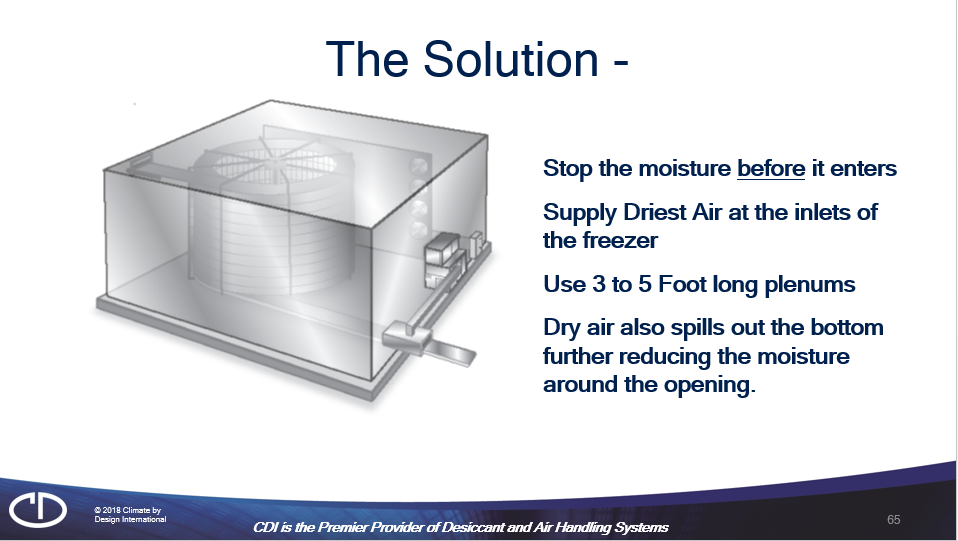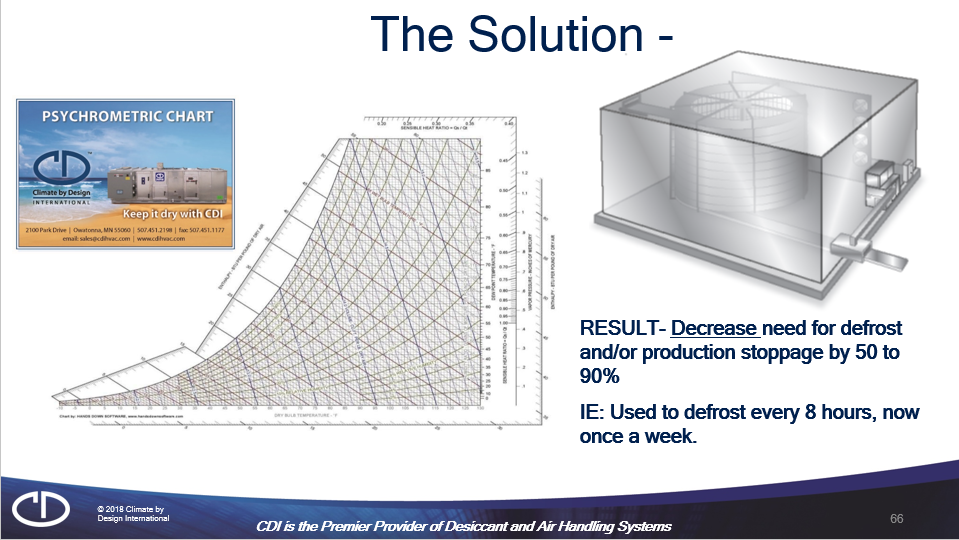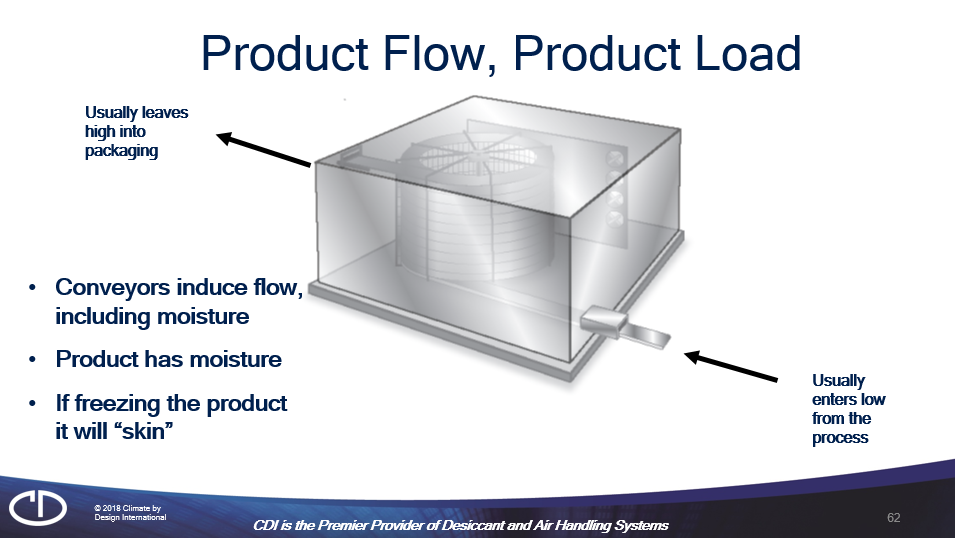In high-throughput frozen food production, spiral freezers are essential for delivering consistent product quality at scale. Yet, they come with a persistent and often underestimated challenge: moisture infiltration. Engineers tasked with designing or optimizing these systems know that ice buildup, frequent defrosting, and safety risks are not just operational annoyances—they’re symptoms of a deeper climate control issue centered around dew point mismanagement.
The Engineering Challenge: Moisture at the Dew Point
While traditional refrigeration systems are capable of lowering air temperature, they are not engineered to actively manage humidity. When warm, moisture-laden air enters spiral freezer environments—through product entry points or from adjacent processing areas—it condenses on any surface below the dew point. This often includes conveyors, coils, and floor surfaces.
Even worse, vapor pressure differentials between the warmer prep areas and the sub-freezing zones inside the spiral freezer can force moisture in, even when the airflow direction seems to suggest otherwise. For engineers, this creates a complex thermodynamic problem: how to maintain environmental separation without relying solely on cold air.
CDI’s Desiccant-Based Dew Point Solution
CDI’s Dry Climate Series tackles the root of this issue by shifting the control strategy from cooling to dehumidifying. Using a desiccant wheel, the system adsorbs water vapor directly from the air—bringing dew point levels well below the surface temperatures of the freezer zone.
This process allows engineers to design a controlled microclimate around the most vulnerable areas of the spiral freezer. Conditioned dry air is ducted through plenums at freezer ingress and egress points, forming a dry-air barrier that intercepts moisture before it can enter and condense.

Unlike traditional air curtains that rely on velocity, CDI’s system uses low-velocity, high-impact airflow, ensuring that the dry zone remains stable and doesn’t contribute to turbulence or unwanted mixing. This approach delivers consistent performance, even in high-traffic or shift-based operations where freezer doors are frequently open.
Measurable Results: From Uptime to Compliance
Reduced Defrost Cycles = More Production Time
In typical spiral freezer operations, frost buildup on evaporator coils and interior surfaces leads to multiple defrost cycles per day—each cycle halting production and disrupting thermal consistency. With CDI’s desiccant system in place, many facilities report reducing defrost frequency to once per week or less.

This means more time for processing, less downtime for recovery, and better overall equipment effectiveness (OEE). For engineers measuring performance through KPIs like throughput, availability, and system reliability, this represents a substantial and sustainable performance gain.
Energy Optimization Across Systems
Refrigeration systems are designed to cool, not dehumidify. When they’re forced to manage latent heat (i.e., remove moisture), efficiency plummets. By offloading that latent load to the desiccant system, evaporators can operate at peak efficiency, focusing solely on lowering air temperature.
This shift not only improves the COP (Coefficient of Performance) of refrigeration systems, but also extends compressor life, reduces fan runtime, and lowers overall energy costs. Facilities implementing CDI solutions often see measurable decreases in kWh usage during peak production periods—a key win for engineers focused on sustainability and energy benchmarking.
Improved Worker Safety
Slippery floors, fogged-over walkways, and low visibility zones near freezer doors all contribute to workplace incidents. These aren’t minor risks—they’re major liabilities in any food processing plant. By maintaining dry, conditioned air around these high-traffic zones, CDI helps eliminate condensation, improve visibility, and reduce injury risk.
Engineers and plant managers benefit from this improved safety profile in both qualitative and quantitative terms: better audit scores, reduced incident rates, and lower insurance premiums tied to safety metrics.
Enhanced Product and Packaging Quality
When products enter spiral freezers through humid air zones, surface moisture can cause serious downstream problems: soggy packaging, misapplied labels, or even microbe growth if the freezing cycle is delayed. With CDI’s system stabilizing the air conditions around the freezer, product surfaces remain dry and freezing occurs as intended—without moisture-related interruptions.

This also supports better packaging adhesion and structural integrity, reducing the likelihood of product loss or rework. In regulated facilities, such stability can also be the difference between passing or failing a food safety audit.
Long-Term Value: Designing for Reliability and Compliance
Lower Maintenance and Reduced Downtime
Engineers are acutely aware that frequent icing and thermal cycling increase wear on mechanical systems. Condensation can short electrical controls, corrode surfaces, and destroy sensors. CDI’s solution minimizes these risks by preventing ice formation entirely, which leads to longer equipment life, fewer emergency repairs, and lower total maintenance overhead.
For teams tasked with predictive maintenance strategies or reliability-centered design, the reduction in reactive maintenance costs is a compelling benefit.
Regulatory Confidence
Food production environments are subject to strict safety and environmental controls. By providing consistent air quality and preventing moisture accumulation, CDI’s desiccant dehumidification supports compliance with FDA, USDA, and SQF standards. It helps engineers satisfy sanitation requirements and environmental control criteria with confidence and repeatability.
This is particularly important for operations working under HACCP plans or third-party audit regimes where environmental control documentation is required.
Flexible System Design and Integration
CDI’s Dry Climate units range from the compact DC-500 to the high-capacity DC-2250, with customizable air volumes and reactivation methods (electric or gas). This enables engineers to match the system to existing HVAC infrastructure, available utilities, and floor space constraints.
Whether integrating into a new facility or retrofitting a legacy operation, the systems are modular, scalable, and designed for ease of installation and service.
Future-Proofing for Energy and Sustainability Goals
As food processors push toward Net Zero emissions goals and ESG benchmarks, CDI’s desiccant systems support long-term sustainability. By reducing energy consumption and refrigerant load, they enable facilities to align with utility rebate programs, carbon tracking initiatives, and corporate sustainability frameworks.
From a forward-looking engineering perspective, desiccant dehumidification is not just about frost prevention—it’s about building operational resilience and energy intelligence into freezer infrastructure.
Conclusion: Engineering the Right Climate for Performance
For engineers designing spiral freezer environments, moisture isn’t just a nuisance—it’s a system variable that must be tightly controlled to protect throughput, safety, and energy performance. CDI’s desiccant dehumidification systems offer a powerful, scalable solution that shifts the focus from reactive frost control to proactive dew point management.
The result is smarter freezer operations: longer uptime, safer work zones, improved product quality, and lower energy costs.
Ready to engineer better control into your freezer operations?
Connect with our team at sales@cdihvac.com or visit www.cdihvac.com to learn more about CDI’s Dry Climate solutions for spiral freezers.
